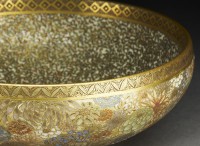Meiji Arts trail
Japanese spirit, Western technology; explore the changing styles and techniques of Meiji decorative arts.

- This is a visual browsing tool that maps objects in this publication, gallery or collection trail by date of creation onto a timeline.
- The circular markers indicate where objects are on the timeline.
- The size of the markers indicates the relative number of objects at that point on the timeline.
- Hover over a marker to find out which objects are represented at that point in time.
- To expand, collapse or hide the timeline, click these symbols
 found at the top right of the timeline.
found at the top right of the timeline.
- 1870
- 1880
- 1890
- 1900
- 1910
- 1920
- 1930
- 1940
During the Meiji period, trade was promoted to provide funds for extensive modernisation within Japan, and artists were encouraged to create works specifically for the overseas market.
Foundation in tradition
The traditional craftsmanship of the Edo period (1600-1868) was a vital foundation for the styles that were developed to meet the demand from the West for innovative concepts in shape and decoration. Artists also experimented with new techniques and styles in response to the European love of decoration. As a result an ornate, highly-decorated export style was developed which was quite unlike the high quality, traditional art produced for the internal Japanese market.
From 1867, Japanese artists and companies started to exhibit works at International Expositions. Western customers were fascinated by the beautiful and unfamiliar ceramics, lacquer and metalwork from this ‘unknown' country. Japanese art from this period had a major impact on contemporary Western artists including Monet, Van Gogh and Degas.
Artistic developments
By 1900, nearly half a century after Japan first opened up to the West, Japanese artists had a better grasp of new Western technology and a deeper understanding of unfamiliar Western design concepts. They were successful in combining Western elements with traditional Eastern ones to create new and modern works in a range of mediums.
Despite the changes that swept Japanese society after the 1850s, the traditional arts were never abandoned. Especially after the early 1880s, attitudes towards Japanese art began to change both in Japan and in the West. As Westerners learnt more about traditional Japanese art, the demand for ornate, specially-made export wares fell. In response, many Japanese craftsmen returned to traditional Japanese and Chinese sources for inspiration.
© 2013 University of Oxford - Ashmolean Museum
